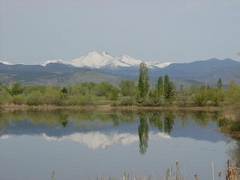"Every town that had 300 people wanted a sugar factory. In fact all of them were circulating petitions for acreage."Three sugar beet factories were opened in the area that year, including two massive facilities in Ft. Collins and Longmont. But the first new factory of 1903 to start slicing beets and producing sugar was in Windsor in November.
Ground was broken for the Windsor factory a year earlier, in November 1902, on the so-called "Hollister place" property, a short distance outside town. The Windsor factory was intended to be an exact duplicate of the Eaton factory located 15 miles away, with the same capacity: 600 tons of beets per day. The factory was funded with stock offered by the Windsor Sugar Company, which had offices in Denver and Windsor. The company's charter was much wider than just sugar manufacturing: they had authorization to pursue business in railway construction, power stations, irrigation and reservoir construction, and livestock breeding.
Like the other factories in the area so far, the Windsor factory was acquired by the New Jersey-based Great Western Sugar Company in 1905. Eric Twitty, in the excellent free Silver Wedge publication (mentioned earlier), has the complete story about the strongarm and hostile consolidation plays that were occuring in the sugar industry at that time.
The Windsor factory from around 1918:

In 1902 with three factories already operating and three more on the near horizon, we start to see some environmental concerns about the harmful industrial waste from the factories. An editorial in the Greeley Tribune from November 1902 presents an alarming wake-up call about the potential impact on their drinking water supply, from the Loveland factory dumping their factory waste into the river:
"Farmers under the Thompson River complain that the refuse from the Loveland sugar factory has contaminated the river water, to say nothing of the stench that arises from the flow. Cattle refuse to drink it, and at times, even as far as Hillsboro is from the factory, from ten to twelve miles, the air is pregnant with foulness that tends to nausea. The water in the the river is of a milky hue and this discoloration can be seen as far as Evans"and went on to say:
"This is not a scare; it is a stern reality."(Hillsboro is just west of Milliken, Evans is on the outskirts of Greeley, and it would be another 68 years before the EPA was created).
The Windsor factory was shut down in 1966, giving it a manufacturing lifetime of 63 years. Unlike most other locations, the main factory was torn down in 1977. Still standing in 2009, for an unknown reason, is the concrete smokestack. Also still remaining is the sugar warehouse portion of the factory and the sugar storage silos that were built later.


Here are those black stars on the masonry again, like seen at Eaton and other factories.

Continuing series on the northeast Colorado beet sugar factories:

 One citizen's view of Longmont, Colorado, USA.
One citizen's view of Longmont, Colorado, USA.

1 comment:
Hi, we live next to the former Spreckles Sugar Factory Plant in Woodland California.
We are seeking information from any former employees or interested parties etc... relating to the lime dust that is blowing into homes, PCB's that were shipped here from other Sugar Factories, Under Ground Storage Tanks UST's, Hexavalant Cromium (HEx Cr), Lead Acetate and Arsenic amonug other contaminates.
The lime ponds were unlined.
You may contact me at info@historicnelsonranch.com
Post a Comment